Caesar Salad is a simplistic dish, made from nothing but a creamy dressing – containing garlic, mayonnaise, anchovies, and Worcestershire sauce – tossed with crisp, romaine lettuce, served piping cold.
Its simplicity is also what predisposes it as one of the most abused dishes in America. The tricky thing is, if any one of the elements of Caesar Salad goes out of whack, the whole thing goes with it, which is why it’s important to define each key element of a perfect Caesar Salad.
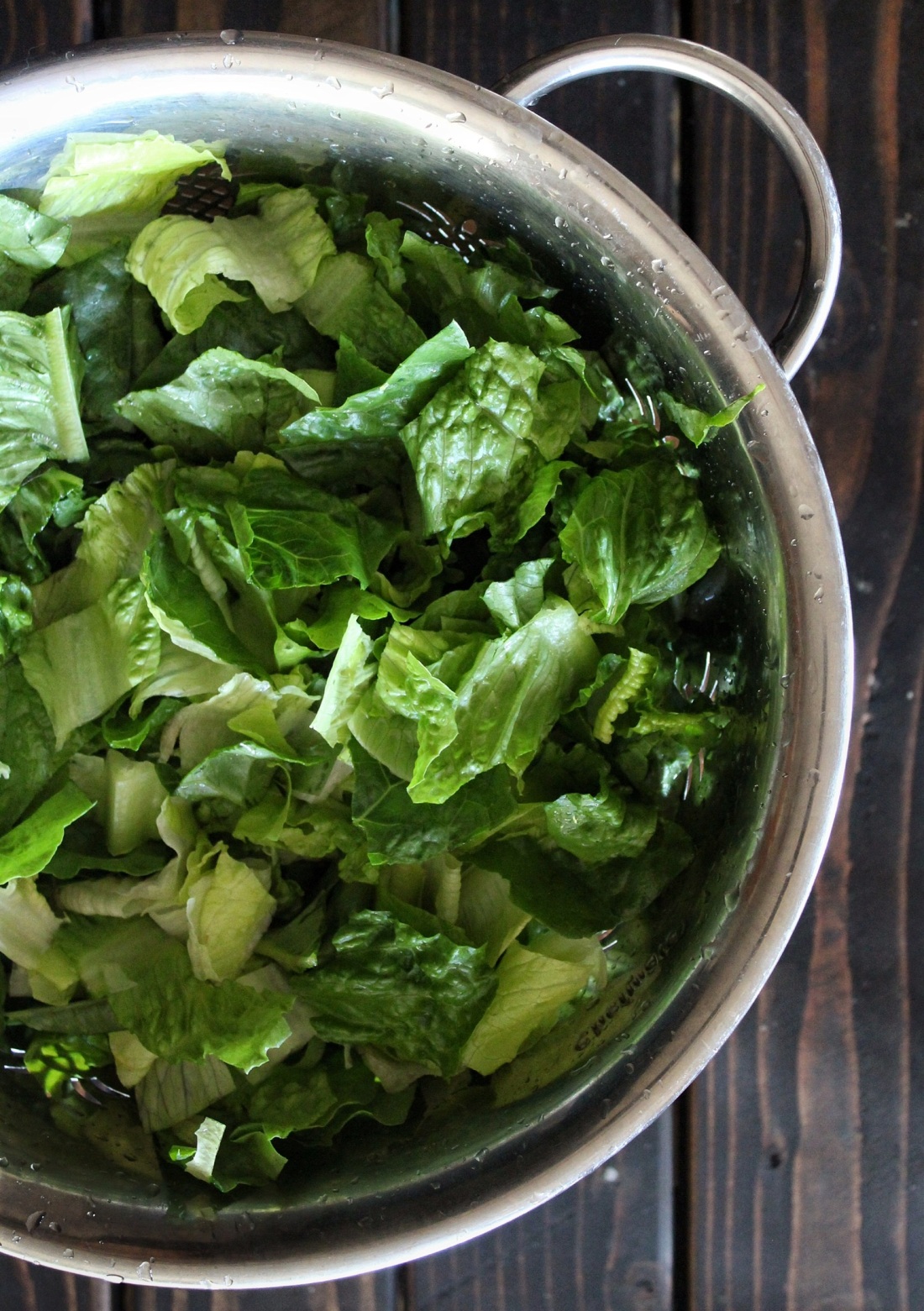
Being the base of the salad, perhaps the most important element is the greens, in Caesar’s case: romaine lettuce. Because of romaine’s high water content, the leaves remain crispy and tender, akin to celery, which makes it the perfect candidate to hold up the heavy dressing.
Keeping the lettuce as cold as possible – without freezing it – is a matter to stay mindful of during the whole process. Store the entire head of lettuce in the fridge for at least four hours before prepping the salad. Once ready, rinse it with cold water to clear the leaves of bugs and soil, cut into proper size, then place back into the fridge while you prep the rest of the ingredients.
After you cut the leaves, you’ll want to keep them away from any excess moisture. Because I don’t own a salad spinner, I place my cut leaves into a raised colander, place that colander into a bowl, and place the entire contraption in the fridge. This way, any remaining water on the leaves can drip into the bowl underneath, keeping the leaves as dry on the exterior as possible without comprising coldness… a technical term.
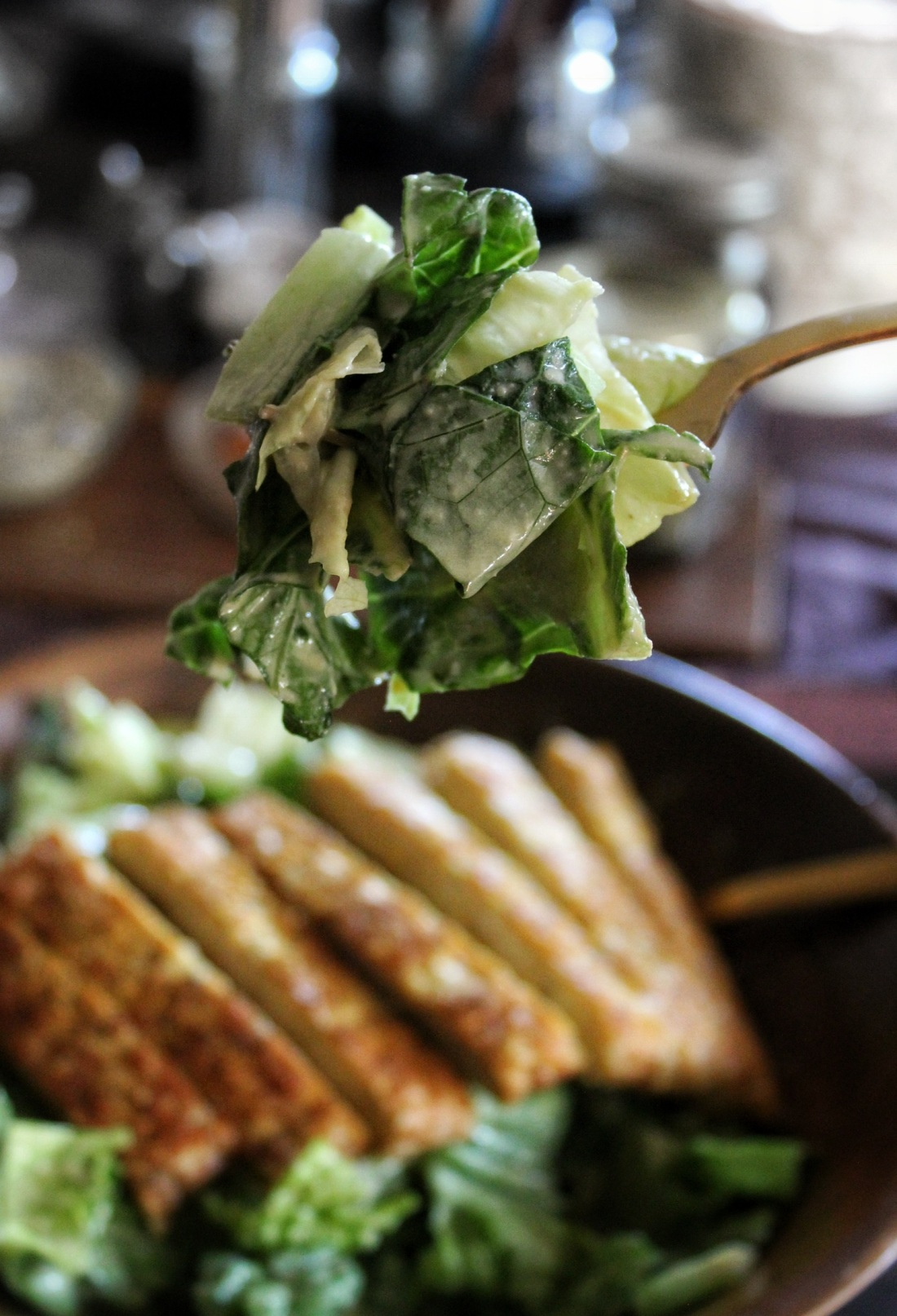
Caesar dressing is what transforms romaine lettuce into an elegant salad worthy of a main course, making it our second key element.
I’m obligated to tell you that this dressing isn’t “traditional,” as it contains no anchovies, mayonnaise, or parmesan. Rather, this is a variation of Caesar Dressing that’s almost identical to the original, without compromising any personal dietary restrictions. With that disclaimer aside, here’s what the breakdown of the dressing looks like:
- Pressure-cooked chickpeas for body, thickness, and resistant starches
- Extra virgin olive oil for creaminess, flavor, and antioxidants
- Nutritional yeast for richness and “cheesiness”
- Fresh garlic for bite, spice, and garliciness
- Lemon juice for tang and acidity
- Dijon mustard for sharpness
- Stevia for a touch of sweetness
- Salt for saltiness, of course
Pressure-cooked chickpeas may sound highly niche, but it’s the only method of cooking legumes that rids them of their lectins. But, if you’re like me and don’t own a pressure cooker, the brand Eden pressure cooks their beans directly in every can, so I used their chickpeas for this dressing.
Also, don’t skimp on the extra virgin olive oil. I ran a couple test trials with a mixture of olive oil and water, but the dressing came out lacking that deep richness that makes Cesar Salads satisfying enough to be a main course. Plus, extra virgin olive oil adds beautiful flavor, is loaded with antioxidants, and keeps you full longer.
To keep the entire salad cold (with the exception of the tempeh), blend the dressing together at least 30 minutes – preferably 1 hour – before tossing it with the romaine, so that it has time to take a chill in the fridge. If you skimp on the cooling, you’ll have a 80° F, room temperature salad, which is not up to No Eggs or Ham par!
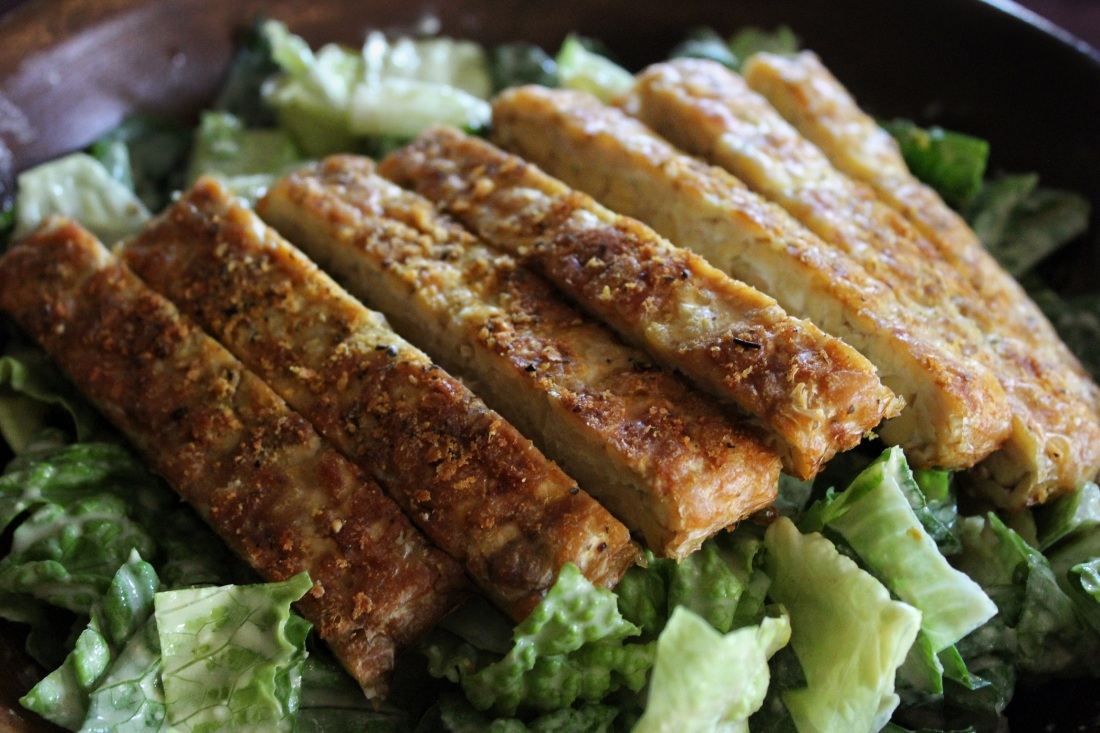
The romaine and dressing are great on their own, but I’m not going to pretend that a single serving of lettuce and dressing is enough to fill me up for more than 30 minutes, no matter how much olive oil is in it. The tempeh transforms this from a side salad into a main entree, because it gives the teeth a chewy texture to tear into, which sends satisfaction levels to the top of the chart. On top of that, tempeh is easy to cook, affordable, and full of protein – 3 ounces contains 8 grams of protein – which makes it perfect for workout and recovery days.
Just be sure to buy tempeh that’s free of any additional seeds, grains, or vegetables. Look for these ingredients on the package when shopping for tempeh: soybeans, vinegar, water, and a starter culture – such as rhizomes oligosporous – which is the ingredient responsible for transforming soybeans into tempeh. Without going too far in depth, the process of fermenting soybeans, which takes course over 2-5 days, removes lectins and estrogen-like compounds that make soy infamous.
No lectins or estrogen-like compounds = clean protein.
Caesar salad may be simple, but that doesn’t disqualify it from being fine fare, whether it be at Carrabba’s or your dinner table. With a few key elements in mind, you can avoid the pitfalls responsible for soggy greens or room temperature dressing, and skip straight to the perfect Cesar Salad on your first attempt.
If you like what your taste buds are tellin’ ya, leave behind a nice rating, share your thoughts with us in the comments, or show us your creations by tagging @noeggsorham on Instagram
Cheers!
Ryan & Kim
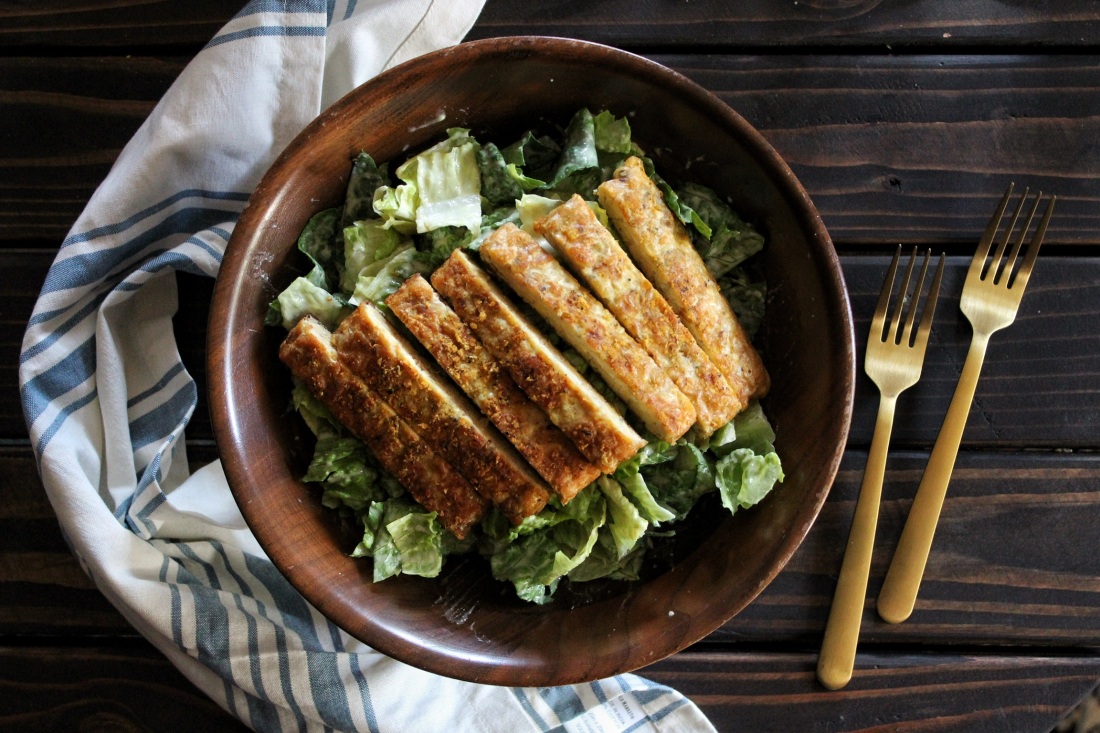
Lectin-Free Cesar Salad
Cold and crisp romaine lettuce tossed in rich, lemon olive oil dressing, served with Italian herb crusted tempeh.
Ingredients
Caesar Salad
- 1 large head romaine lettuce (1 1/2 medium heads)
- 3/4 c pressure-cooked garbanzo beans (or Eden’s Garbanzo Beans)*
- 2 small cloves of garlic, minced
- 5-6 tbsp extra virgin olive oil
- 2 tbsp lemon juice
- 2 tbsp nutritional yeast
- 1 tsp dijon mustard
- 6 drops of liquid stevia
- Heavy pinch of salt
Italian Crusted Tempeh
- 6 oz tempeh
- 2 tbsp olive oil
- 2 tsp nutritional yeast
- 1/4 tsp of truffle salt (or substitute w/ sea salt)
- 1/4 tsp Italian seasoning
- Few grinds of black pepper (about 1/8 tsp)
Directions
- To assemble dressing: combine chickpeas, garlic, 5 tbsp olive oil, lemon, yeast, mustard, stevia, and salt in a mini food processor or personal-sized blender and blend until smooth, adding the additional tablespoon of olive oil if the dressing is too thick to blend.
- Transfer dressing to an airtight container and place in fridge for at least 30 minutes, preferably 1 hour, until ready for use.
- To prepare lettuce: Cut romaine head into large, bite sized pieces, which is accomplished by cutting the head down the center vertically, rotating it 90°, and making another vertical cut down the center. Then, cut horizontally across the head in sections about 1 inch deep until you reach the bottom of the head.
- Place cut lettuce in a large raised colander (a colander with legs or a rim on the bottom) and rinse thoroughly with cold water, rubbing off any noticeable bugs or specks of dirt. Place colander into an even larger bowl and place entire contraption in fridge while prepping tempeh.
- For tempeh: In a small bowl, mix together yeast, truffle salt, pepper, and Italian seasonings. Set aside.
- Add block of tempeh and enough water to rise 3/4 of the way up the tempeh in a medium non-stick pan over high heat. Bring to a boil and maintain until all the water has evaporated. Transfer tempeh to a cutting board and lower heat to medium.
- Evenly sprinkle spice mixture onto each side of tempeh and gently pat down to ensure stickage.
- Pour 2 tablespoons of olive oil into pan. Once oil shimmers, add tempeh, and cook on each side until golden brown, 2-3 minutes per side. Turn off heat, transfer to a cutting board, and cut into strips of desired thickness (reference photos in post). Set aside.
- To assemble salad: In a large mixing bowl, toss together most of the lettuce and all of the dressing for at least 1 minute, until the dressing is evenly distributed. If there’s too much dressing on the leaves for your liking, toss in the rest of the lettuce. Otherwise, continue.
- Distribute dressed lettuce among two plates and serve with equal amounts of tempeh strips. The dressing will keep in the fridge for up to five days. However, once the salad’s assembled, it should be eaten fresh.
*There’s no need to rinse garbanzo beans with water. Simply strain the can of as much liquid as you can without removing them – some thick liquid will remain, which should be included as part of the 3/4 c.
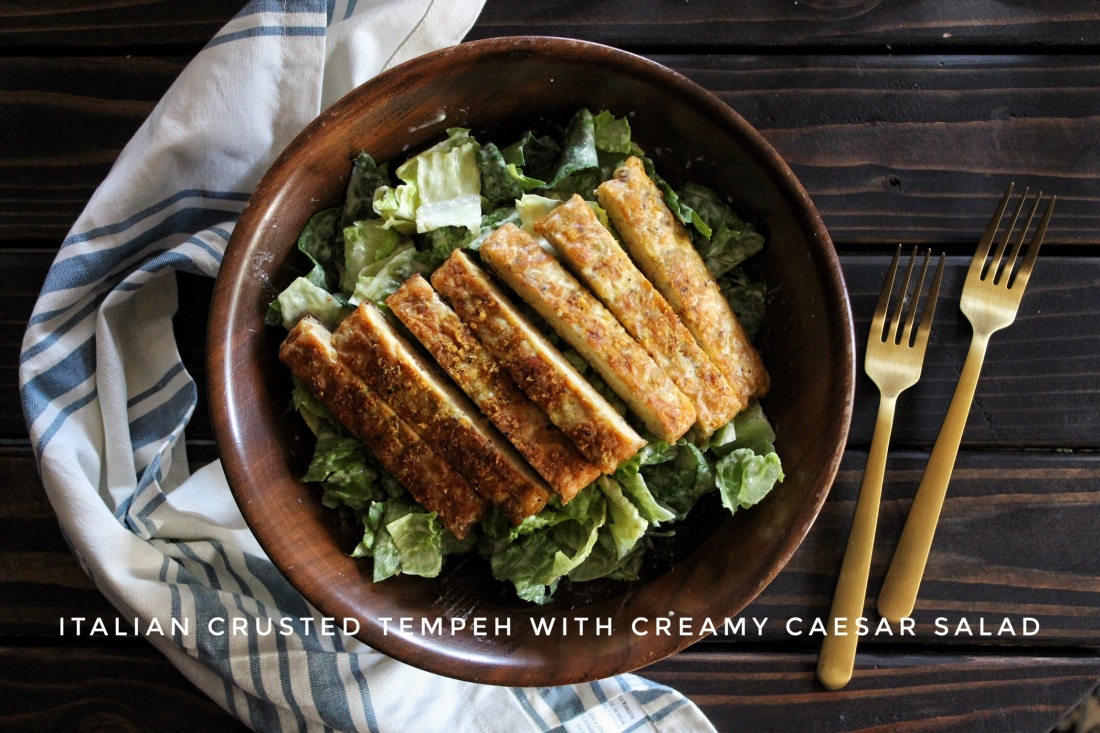
Love this one!
LikeLike